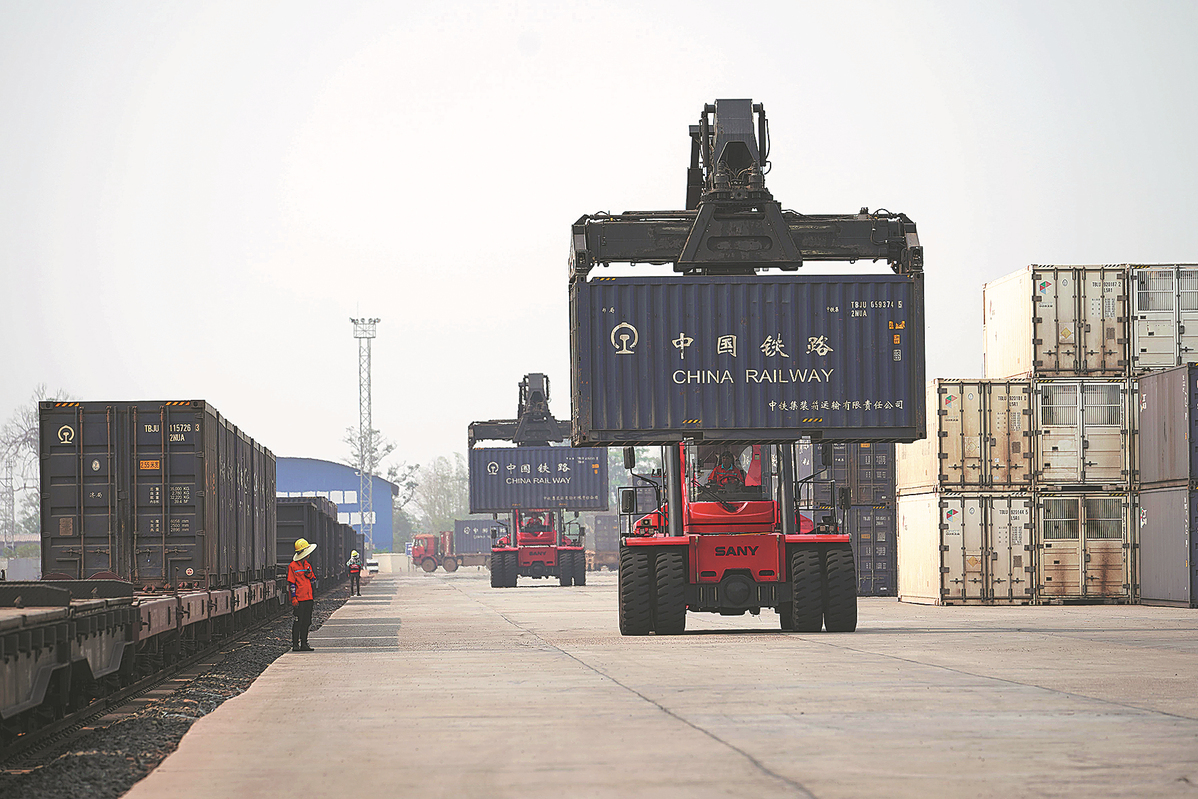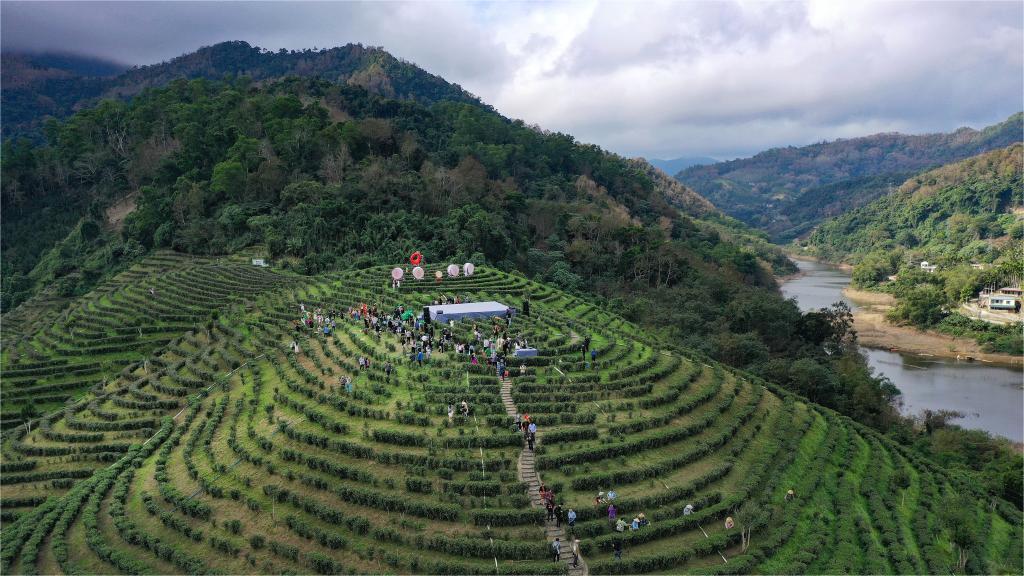Country presses the accelerator on rail development

A photo taken from a drone shows Tegalluar station in Bandung, Indonesia. By the end of last year, more than one million people had taken the Jakarta-Bandung High-Speed Railway. [XU QIN/XINHUA]
Last year was a fruitful one for China's expertise in building railway networks, which gained wider recognition from the international community.
In April, passenger service began on the China-Laos Railway. As of Dec 5, the cross-border link had handled more than 100,000 trips by travelers from over 70 countries.
In October, the high-profile Jakarta-Bandung High-Speed Railway commenced operation in Indonesia — the first such line in Southeast Asia. The project was the first overseas venture to rely wholly on Chinese railway systems, technology and components.
Seven months earlier, the Chinese-built Belgrade-Novi Sad section of the Serbia-Hungary Railway marked the first anniversary of its operation. Nearly 3 million passenger trips were made on the line in its first year.
Ju Guojiang, president of China Railway International, a subsidiary of China State Railway Group, which supervises overseas railway projects, said, "The biggest advantage of Chinese rail going global is that we have a comprehensive system that includes all the elements needed and the entire industry chain."
"This means that China can offer a comprehensive plan, including surveying, designing and construction, as well as providing all supplies and materials. We can also offer operating plans following the opening of a railway," Ju added.
For example, when there was a shortage of a particular type of material before the Jakarta-Bandung High-Speed Railway opened, an urgent shipment from China solved the problem, Ju said.
"If a similar problem occurred in Europe, it may take six months to a year to tackle it. Thanks to China's strong industrial capability to solve comprehensive problems, we can resolve such difficulties in just one month," he added.
China State Railway Group said the nation's rail sector has strengthened international cooperation by insisting on adhering to the principles of maintaining high standards and sustainability while benefiting the people. The sector also focuses on assisting the Belt and Road Initiative and sharing the experiences of railway construction and operation globally.

Passengers cheer during a trip on the China-Laos Railway in April. [HU CHAO/XINHUA]
Travel time cut
The 142-kilometer Jakarta-Bandung High-Speed Railway, which has a designated maximum speed of 350 kilometers per hour, cut travel time between the Indonesian capital and the popular tourist destination from 3 hours 30 minutes to 40 minutes.
As of Dec 24, the railway had handled more than 1 million passenger trips.
The rapidly growing passenger flow prompted PT Kereta Cepat Indonesia-China, or PT KCIC, a joint venture consortium between Indonesian and Chinese companies that constructs and operates the railway, to increase services to 48 trips a day, up from just 14 previously.
Inspired by the sound of a fast-moving train, Indonesians named the bullet train "Whoosh".
Indonesian President Joko Widodo officially opened the railway on Oct 2, after taking a test ride on it with several top Indonesian officials the previous month. Services began commercial operation on Oct 17.
Widodo said the construction of the bullet train marked Indonesia's modernization, adding that it also showed the nation could operate an efficient, eco-friendly public transportation system.
Dwiyana Slamet Riyadi, president of PT KCIC, said he hopes the railway can bring a new and efficient lifestyle to Indonesia.
Among the first passengers to use the service was Ahmad, who like many Indonesians has only one given name. He described the train as "very comfortable, stable, clean and luxurious".
"I was really amazed by how quickly we arrived in Bandung. I didn't have any time to sleep, as the trip is so short," he said, adding that the train is also child-friendly.
Since mid-October, working groups from China and Indonesia have called for high-quality operation of the high-speed railway by catering to passengers' needs. These efforts include promoting online ticket sales, improving boarding and arrival services, and integrating other transit systems with the railway.
Restaurants and convenience stores have opened at three stations along the line, and food and drinks are also available on the train.
Ju, from China Railway International, said: "Judging from current feedback, the opening of the Jakarta-Bandung High-Speed Railway has had a significant global influence. We have gained a very good reputation in Europe, Southeast Asia, and Southern Asia, and also in countries with advanced high-speed railway technologies, such as Japan, France and Germany.
"After China, Indonesia is the second country in the world to have a high-speed railway running at a maximum speed of 350 kilometers per hour."

Goods are loaded at Vientiane station on the China-Laos Railway in April. [XING GUANGLI/XINHUA]
Progress made
As the new railway in Indonesia has attracted global attention, the China-Laos Railway has also made notable progress after operating for two years.
The 1,035-km electrified line links Kunming, capital of Yunnan province, with Vientiane, the Laotian capital.
The link has cut travel time between the two cities to 10 hours and 30 minutes, including inspections at customs clearance stations on the Chinese and Laotian borders.
The railway marked its second anniversary on Dec 2. By then, 24.2 million passenger trips had been made on the line, with 3.74 million taking place in the Laotian section. The railway has transported 29.1 million metric tons of cargo, 6 million tons of which were cross-border goods.
Passenger train services between Kunming and Vientiane began on April 13.
Since then, more than 95,000 passengers from 72 countries and regions have used the service to travel between the two cities, and the number of monthly international passenger trips on the route has risen from about 600,000 to 1.1 million.
A World Bank study titled "From Landlocked to Land-Linked: Unlocking the Potential of Lao-China Rail Connectivity" said the China-Laos Railway could raise the aggregate income in Laos by up to 21 percent in the long term.
Transit trade along the line through Laos is estimated to reach 3.9 million tons annually by 2030, which would include moving an estimated 1.5 million tons of goods from ships onto the railway, the study said.
A Beijing woman, who gave her name only as Wang, is considering taking her family on the China-Laos Railway to spend Spring Festival in Laos.
"Traveling with my child and parents, I prefer a destination that is warm and convenient, and which we can visit on a reasonable budget," she said, adding she was also attracted by the lack of a luggage limit on the trains.
A friend of Wang's, who has traveled by train to Luang Prabang, a popular tourist destination in northern Laos, strongly recommended the service to her.
Stuart Hart, a tourist from the United Kingdom visiting Laos, said, "The service is fast, efficient and pleasant." Hart, who lived in Shanghai for two years and has used the service twice, said it is as good as the trains he experienced in China.
Tourists Juliet and Dean O'Reilly, also from the UK, said Vientiane Railway Station is "big and beautiful". The couple traveled from the Laotian capital to Luang Prabang.
Vongthong Somphavath, a Luang Prabang native who works in Vientiane, said: "Before the railway opened, the bus journey between Vientiane and Luang Prabang took an entire day. It is not a pleasant experience sitting on a crowded bus during that time, and the winding mountain road made the trip even worse."
She added that the journey by train only takes about two hours.
"In addition to the speed of the train, the view along the line is much better than that from the bus. There have been some complaints about ticket prices, but the tickets always sell out very quickly," she said.

A train on the China-Laos Railway travels through Xishuangbanna Dai autonomous prefecture, Yunnan province, in April, heading to Vientiane, the Laotian capital. [JIANG WENYAO/XINHUA]
Rewards netted
International cooperation between China and other countries on railways has not only borne fruit in Asia, but also in Europe.
March 19 marked the first anniversary of the opening of the Belgrade-Novi Sad section of the Serbia-Hungary Railway, the first high-speed railway in Serbia and also a landmark Belt and Road Initiative project in Europe.
The 80-km line, which has a designated top speed of 200 km/h, has cut travel time between the two cities from 90 minutes to about 30 minutes, significantly boosting social and economic development in the region.
Marko Jeremic, head of infrastructure at Serbian Railways, said, "The collaboration with Chinese companies made it possible for us to become the leader in the western Balkans, with the introduction of the high-speed line.
"We became the leader because no other neighboring countries — Croatia, Hungary and Bulgaria — have high-speed lines operating at more than 160 kilometers per hour."
Ju said successful overseas projects have shown that China has an advanced high-speed railway system and leads railway development in some areas of the world.
Zhao Xianghong, deputy director of the Science, Technology and Information Research Institute at the China Academy of Railway Sciences, said, "China is a world leader in some aspects of high-speed railway development."
China State Railway Group said the nation now boasts trains running at the highest commercial speeds, and the greatest variety of operational scenarios, transforming it from a follower of high-speed rail development to a true leader in technologies.
Xinhua contributed to this story.
Photos
Related Stories
- New Fuxing high-speed trains to be put into service in NW China
- Snow-capped serenity: Unveiling the majestic Lijiang-Shangri-La Railway
- China's Chengdu, Chongqing operate over 5,000 China-Europe freight trains in Jan-Nov
- Bulldozers fix up rail tracks before Spring Festival travel rush
- Staff members busy servicing EMU trains in Inner Mongolia
- Lijiang-Shangri-La railway: a journey of beauty in Yunnan
Copyright © 2024 People's Daily Online. All Rights Reserved.









